452 Search Results for visual supports
December 5, 2013
by Robin Parker -
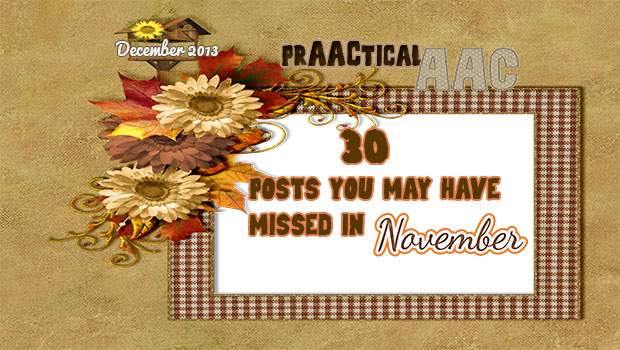
Strategy of the Month Thoughts on Teaching Core Vocabulary Teaching Core Vocabulary with Direct Instruction Strategies New Word Teaching: A Look Inside Some PrAACtical Therapy Sessions Core Words, Direct Vocabulary Instruction, & the Beginning Communicator PrAActical Thinking Fun Friday- 5 Tips for Talking About Halloween After it is Over 31 Posts You May Have Missed in October A PrAACtical Literacy Activity for Beginning Communicators Writing Goals for AAC Learners Fun Friday: Holiday Shopping with a Purpose 10 Apps to Gift to An SLP Hockey Lessons Watch it Wednesday: Using Routines to Promote Interactions by the Watson Institute Throwback Thursday: Say This, Not That to Reinforce Vocabulary Learning Fast FAACt Friday: AAC’s 1st Appearance in the Professional Literature How Do You Teach Others to Implement AAC Facilitation Skills? Watch it Wednesday: Time Timers At the Very Beginning: Working with Pre-Intentional Communicators Display Stand for Visual Supports or Books PrAACtical Thoughts on... [Read More...]
November 11, 2013
by Robin Parker -
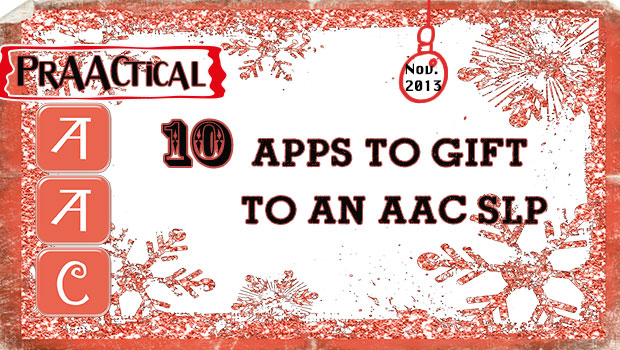
It’s definitely time to think about the holidays because they are almost here. Apps are often a great gift for your colleagues or for the SLP working with your child. Here are just a few suggestions that will help the SLP. Please feel free to share others you think should be added to this list. Evaluation Genie – This app is an informal assessment tool that helps with identifying skill areas that relate specifically to the language representation methods commonly found on augmentative communication systems. There are 14 subtests that help with identifying the features for an AAC device that a student would need. The student responses are recorded and easily reportable. ATEval2Go – designed helps guide you through a template for technology considerations so that the SLP can document observations and information in a structured manner. All the documentation can then generate an editable usable report. Additionally, a goal bank can be... [Read More...]
November 3, 2013
by Robin Parker -
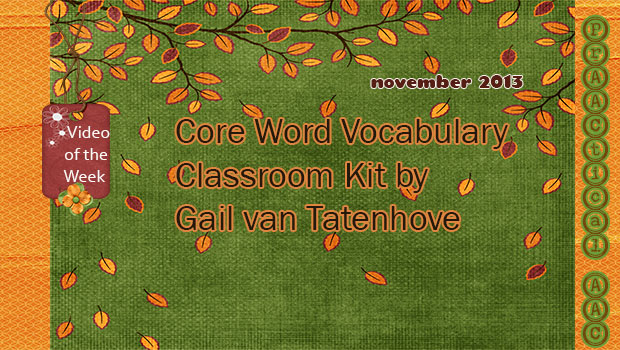
Need some help with core vocabulary teaching? Check out The Core Vocabulary Classroom Kit by Gail Van Tatenhove. Really awesome visual supports to go with core word teaching and active learning. *There is a fee for this kit. However, Gail Van Tatenhove also has many free resources on her website and on Minspeak’s website. **We receive no financial benefit from this product. We just think it is a great resource.
November 2, 2013
by Carole Zangari -

Teaching new words is something SLPs plan for in almost every service delivery setting. This month, we’ll focus on vocabulary instruction for core and extended vocabulary. Thoughts on Teaching Core Vocabulary In Advance Plan ahead. Make a rough plan of the core words you will teach and when you will introduce them to the AAC learner. Make sure there is plenty of variety, especially pronouns, verbs, prepositions, conjunctions, and determiners. Words for talking about time (e.g., now, later), asking questions (e.g., what, where), and negation (e.g., not) are important, too. Here’s a link to our post on A Year of Core and A Year of Core, Unity Style. Ensure that the AAC learner has access to communication aids with an adequate base of core vocabulary. What if the learner doesn’t have an SGD or AAC app that is core language based? If you can update that to something with good core... [Read More...]
October 31, 2013
by Robin Parker -
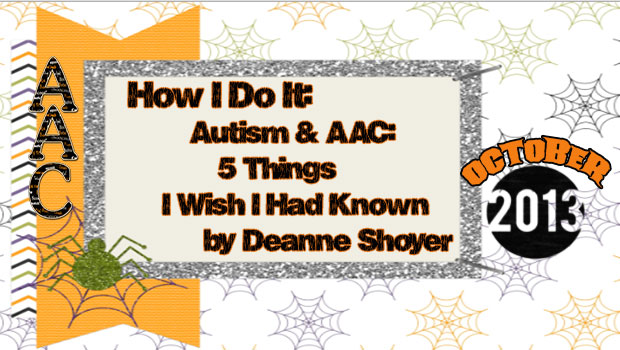
We are so pleased to have connected with Deanne Shoyer from Small But Kinda Mighty and even happier that she is our guest blogger today. Deanne is a mom of twin boys who both are on the autism spectrum. Deanne successfully fundraised to buy iPads for her boys and has been active for more than 3 years in social media and in the special needs app community. She has written about many things but often focuses on implementing AAC in a very PrAACtical way. Please feel free to share this very important post as she highlights AAC, what she has learned, and how it may help others. by Deanne Shoyer at Small But Kinda Mighty (original post at Small But Kinda Mighty) In the title of this post I’ve linked autism and AAC for a specific reason. A lot of the points here are equally applicable to people who have a... [Read More...]
October 26, 2013
by Robin Parker -
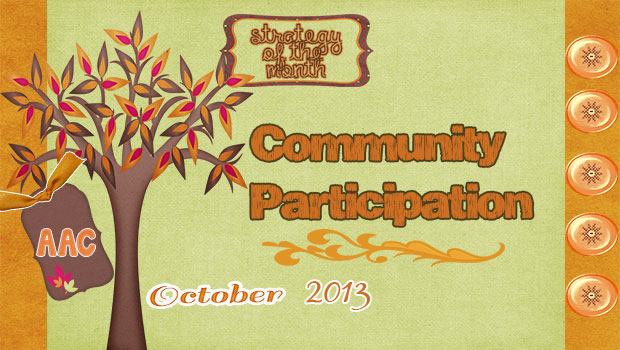
Community participation and communication for AAC users is an integral part of of developing, growing up, and having inclusive opportunities. We often relate community participation to quality of life indicators. Community participation for AAC users begins from the… beginning. Young children can order in restaurants, use picture menus, and have access to many inclusive events. As children grow into adolescents and adults, community participation involves post secondary options, employment, and community living. Perspectives from AAC Users Have communication displays and devices available at ALL times– You need access to a communication system(s) to participate in all situations. Remember to take AAC with you. The sooner the AAC user becomes responsible for taking or telling someone to take the device/displays with them the easier it becomes. For mobile technology systems, there are rugged cases that withstand wind, water, even medical waste (see Lauren Enders Pinterest boards for case and accessory options).... [Read More...]
October 24, 2013
by Robin Parker -

Cooking is a great activity as the platform for meaningful language experiences for both children and adults. Halloween often involves candy and tasty treats. However, there are also plenty of healthy Halloween foods (e.g., carrot pumpkins, tangerine & celery pumpkins, or apple teeth to name just a few). Then comes Thanksgiving and all the recipes that go along with it (e.g., lots of opportunity for repetition with variety). Everyone can be involved with cooking, although just because you cook doesn’t mean you need a stove. From spooky chex mix to more elaborate cookie and cake decorations, there is a ton of active participation and conversation that can be incorporated into cooking. And the fun and rewards (eating) are built-in. Although there are plenty of Halloween recipes, many recipes can be turned ‘spooky’ with an addition/modification of Halloween shapes or colors. You can cook using core words and/or focusing on the... [Read More...]
October 21, 2013
by Robin Parker -
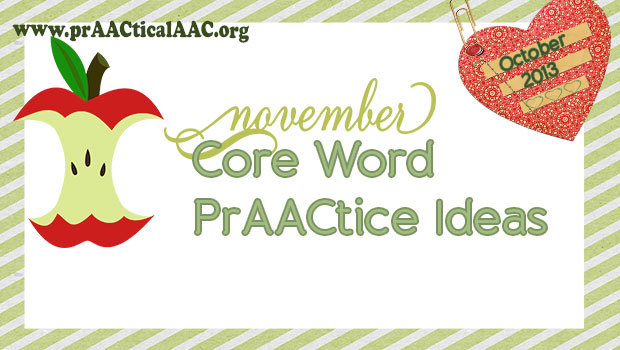
More core word prAACtice ideas. Whether you are just getting started or have been working with core word vocabulary for a long time, the teaching strategies you use to TEACH, helps turn regular words into real communication and language. Provide Aided Language Input- ALI in Meaningful Language Experiences. PrAACtice USING core words in many, many opportunities. Authentic, meaningful prAACtice is fun for everyone. This core word prAACtice is for November. There is a lot of food, leaves, changes of weather, thankfulness, sharing, and holiday spirit. Here are some ideas of activities that can go with the core word words, phrases and sentences: Do art project– Make a turkey because there are many opportunities to use body. From asking for the ‘body of the turkey” and asking for “feathers of the body” there can 50-100 opportunities for prAACtice. You can do this with a beginning communicator who can ask for a... [Read More...]
October 14, 2013
by Carole Zangari -
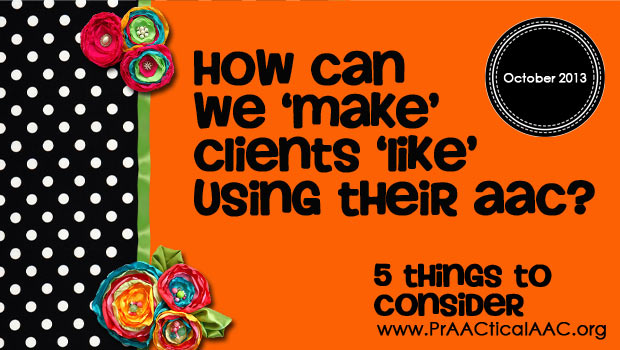
That’s a question we hear from time to time, and it often stops us in our tracks. The good thing about this question is that is signals that the clinician recognizes a stumbling block and is searching for a way around it. Like many things in our lives as SLPs, it’s all about problem-solving. So, how DO you make learners like their AAC? Well, for starters, we don’t like ‘making’ people do anything. Offer, entice, tempt? Yes, frequently. ‘Make’? Not our first, second, or third choice. If we have a really strong rationale and we’ve run out of other options, we may go there. When it comes to helping our clients learn to like their AAC systems, here are some things we think about. 1. We like what we’re good at: Until someone is proficient at aspects of their AAC system, it will feel like work. Why? Because it is... [Read More...]
September 23, 2013
by Robin Parker -
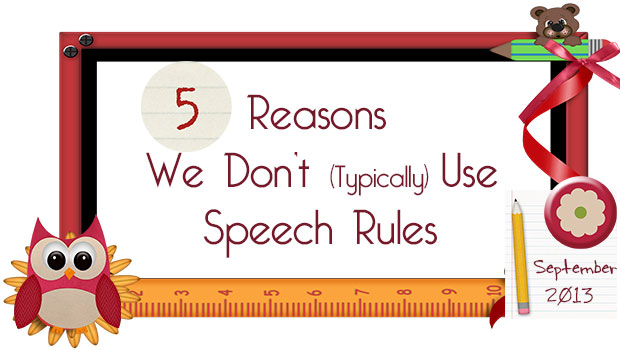
We love organized productive speech therapy sessions. But, we don’t typically use speech rules in our sessions. It’s not that we are inherently against ‘behavior speech rules’ but overall, we don’t use them. Here are some of the reasons why: We use meaningful language activities. We try to use meaningful, fun, and engaging activities so learners want to participate. Even when we think an activity is enjoyable and it is not, it becomes enjoyable and meaningful to “stop” the activity. It is helpful to think about meaningful and fun from the learner’s perspective and not just ours. For example, having a pleasant conversation about awesome pretty pictures would be enjoyable for many students. However, if conversation is difficult, maybe not so much. It’s not that we would not work on conversation, but the activity structure may involve clear beginnings and endings to the conversation, a ‘take home poster’, and/or a... [Read More...]









